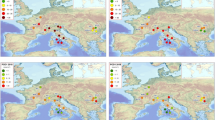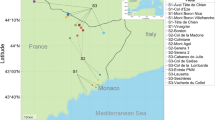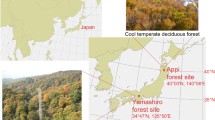Abstract
Biologically meaningful and cost-effective indicators are needed for assessing and monitoring the impacts of tropospheric ozone (O3) on vegetation and are required in Europe by the National Emission Ceilings Directive (2016). However, a clear understanding on the best suited indicators is missing. The MOTTLES (MOnitoring ozone injury for seTTing new critical LEvelS) project set up a new generation network for O3 monitoring in forest plots in order to: 1) estimate the stomatal O3 fluxes (Phytotoxic Ozone Dose above a threshold Y of uptake, PODY); and 2) collect visible foliar O3 injury, both within the forest plot (ITP) and along the Light Exposed Sampling Site (LESS) along the forest edge. Nine forest sites at high O3 risk were selected across Italy over 2017 − 2019 and significant correlations (p < 0.05) were found between the percentage of symptomatic plant species within the LESS, and POD1 (PODY, with Y = 1 nmol O3 m−2 s−1) calculated for mixed forest species (r = 0.53) and with the occurrence and severity of visible foliar O3 injury on the dominant species in the plots (r = 0.65). A generic flux-based critical level for mixed forest species was derived within the LESS and it was recommended using 11 mmol m−2 POD1 as the critical level for forest protection against O3 injury, similar to the critical level obtained in the ITP (12 mmol m−2 POD1). It was concluded that the frequency of symptomatic plant species within a LESS is a suitable and effective plant-response indicator of phytotoxic O3 levels in forest monitoring. LESS is a non-destructive, less complex and less time-consuming approach compared to the ITP for monitoring foliar O3 injury in the long term. Assessing visible foliar O3 injury in the ITP might only underestimate the O3 risk assessment at individual sites. These results are biologically meaningful and useful to monitoring experts and environmental policy makers.


© 2019 by LIFE15 ENV/IT/000,183 MOTTLES


Similar content being viewed by others
References
Agathokleous E, Feng Z, Oksanen E, Sicard P, Wang Q, Saitanis CJ, Araminiene V, Blande JD, Hayes F, Calatayud V, Domingos M, Veresoglou SD, Peñuelas J, Wardle DA, De Marco A, Li Z, Harmens H, Yuan X, Vitale M, Paoletti E (2020) Ozone affects plant, insect, and soil microbial communities: a threat to terrestrial ecosystems and biodiversity. Sci Adv 6: eabc1176.
Araminienė V, Sicard P, Anav A, Agathokleous E, Stakėnas V, De Marco A, Varnagirytė-Kabašinskienė I, Paoletti E, Girgždienė R (2019) Trends and inter-relationships of ground-level ozone metrics and forest health in Lithuania. Sci Total Environ 658:1265–1277
Bussotti F, Ferretti M (2009) Visible injury, crown condition, and growth responses of selected Italian forests in relation to ozone exposure. Environ Pollut 157:1427–1437
Bussotti F, Gerosa G (2002) Are the Mediterranean forests in Southern Europe threatened from ozone? J Mediterr Ecol 3:23–34
Bussotti F, Cozzi A, Bettini D (2003) Ozone-like visible foliar symptoms at the permanent monitoring plots of the CONECOFOR programme in Italy. Annali dell’Istituto Sperimentale per la Selvicoltura 30:99–106
Calatayud V, Cerveró J, Calvo E, García-Breijo FJ, Reig-Armiñana J, Sanz MJ (2011) Responses of evergreen and deciduous Quercus species to enhanced ozone levels. Environ Pollut 159:55–63
De Marco A, Sicard P (2019) Why do we still need to derive ozone critical levels for vegetation protection? Opinion paper—IJESNR 21—October 2019
De Marco A, Sicard P, Fares S, Tuovinen J-P, Anav A, Paoletti E (2016) Assessing the role of soil water limitation in determining the Phytotoxic Ozone Dose (PODY) thresholds. Atm Environ 147:88–97
De Marco A, Proietti C, Anav A, Ciancarella L, D’Elia I, Fares S, Fornasier MF, Fusaro L, Gualtieri M, Manes F, Marchetto A, Mircea M, Paoletti E, Piersanti A, Rogora M, Salvati L, Salvatori E, Screpanti A, Vialetto G, Vitale M, Leonardi C (2019) Impacts of air pollution on human and ecosystem health, and implications for the National Emission Ceilings Directive: Insights from Italy. Environ Int 125:320–333
Ferretti M, Fischer R, Mues V, Granke O, Lorenz M, Seidling W (2017) Part II: basic design principles for the ICP forests monitoring networks. In: UNECE ICP Forests Programme Co-ordinating Centre (ed) Manual on methods and criteria for harmonized sampling, assessment, monitoring and analysis of the effects of air pollution on forests. Thünen Institute of Forest Ecosystems, Eberswalde, Germany, p. 21
Gerosa G, Marzuoli R, Bussotti F, Pancrazi M, Ballarin-Denti A (2003) Ozone sensitivity of Fagus sylvatica and Fraxinus excelsior young trees in relation to leaf structure and foliar ozone uptake. Environ Pollut 125:91–98
Girgždienė R, Serafinavičiūtė B, Stakėnas V, Byčenkienė S (2009) Ambient ozone concentration and its impact on forest vegetation in Lithuania. Ambio 38:432–436
Hoshika Y, Fares S, Savi F, Gruening C, Goded I, De Marco A, Sicard P, Paoletti E (2017) Stomatal conductance models for ozone risk assessment at canopy level in two Mediterranean evergreen forests. Agric For Meteorol 234:212–221
Hoshika Y, Carrari E, Mariotti B, Martini S, De Marco A, Sicard P, Paoletti E (2020a) Flux-based ozone risk assessment for a plant injury index (PII) in three European cool-temperate deciduous tree species. Forests 11:82
Hoshika Y, Fares S, Pellegrini E, Conte A, Paoletti E (2020b) Water use strategy affects avoidance of ozone stress by stomatal closure in Mediterranean trees—a modelling analysis. Plant Cell Environ 43:611–623
Hoshika Y, Martini S, Paoletti E (2020c) Flux-based risk assessment of ozone visible foliar injury in Piedmont region. In: Webinar MITIMPACT (ed) Effets de la Pollution de l’air et du Changement Climatique sur les forêts Méditerranéennes. https://youtu.be/6aHKdS1Kd-g. Accessed 2 Oct 2020
Jarvis PG (1976) The interpretation of the variations in leaf water potential and stomatal conductance found in canopies in the field. Royal Soc Publish 273:593–610
Karnosky DF, Gagnon ZE, Dickson RE, Coleman MD, Lee EH, Isebrands JG (1996) Ozone exposure of Populus tremuloides clones and seedlings. Can For Res 26:23–37
Lefohn A, Malley C, Smith L, Wells B, Hazucha M, Simon H, Naik V, Mills G, Schultz MG, Paoletti E, De Marco A, Xu X, Zhang L, Wang T, Neufeld HS, Musselman RC, Tarasick D, Brauer M, Feng Z, Tang H, Kobayashi K, Sicard P, Solberg S, Gerosa G (2018) Tropospheric ozone assessment report: global ozone metrics for climate change, human health, and crop/ecosystem research. Elem Sci Anth 6:28
Miller PR, Stolte KW, Duriscoe D, Pronos J, Tech C (1996) Monitoring Ozone Air Pollution Effects on Western Pine Forests. U.S. Department of Agriculture, Forest Service, Pacific Southwest Research Station, Albany, CA, USA; PSW-GTR-155
Moura BB, Alves ES, Marabesi MA, Ribeiro de Souza S, Schaub M, Vollenweider P (2018) Ozone affects leaf physiology and causes injury to foliage of native tree species from the tropical Atlantic Forest of southern Brazil. Sci Total Environ 610–611:912–925
NEC Directive (2016) Directive 2016/2284 of the European Parliament and of the Council of 14 December 2016 on the reduction of national emissions of certain atmospheric pollutants, amending Directive 2003/35/EC and repealing Directive 2001/81/EC. In: EC Official Journal of the European Union L. 344 of 17.12.2016
Nunn AJ, Kozovits AR, Reiter IM, Heerdt C, Leuchner M, Lütz C, Liu X, Löw M, Winkler JB, Grams TEE, Häberle KH, Werner H, Fabian P, Rennenberg H, Matyssek R (2005) Comparison of ozone uptake and sensitivity between a phytotron study with young beech and a field experiment with adult beech (Fagus sylvatica). Environ Pollut 137:494–506
Paoletti E (2006) Impact of ozone on Mediterranean forests: a review. Environ Pollut 144:463–474
Paoletti E (2007) Ozone impacts on forests. CAB Reviews: perspectives in agriculture, veterinary science. Nut Nat Resour 2(68): 13
Paoletti E, Alivernini A, Anav A, Badea O, Carrari E, Chivulescu S, Conte A, Ciriani ML, Dalstein-Richier L, De Marco A, Fares S, Fasano G, Giovannelli A, Lazzara M, Leca S, Materassi A, Moretti V, Pitar D, Popa I, Sabatini F, Salvati L, Sicard P, Sorgi T, Hoshika Y (2019) Toward stomatal-flux based forest protection against ozone: the MOTTLES approach. Sci Total Environ 691:516–527
Percy KE, Legge AH, Krupa SV (2003) Tropospheric ozone: a continuing threat to global forests? Dev Environ Sci 3:85–118
Proietti C, Anav A, De Marco A, Sicard P, Vitale M (2016) A multi-sites analysis on the ozone effects on Gross Primary Production of European forests. Sci Total Environ 556:1–11
Schaub M, Skelly JM, Zhang JW, Ferdinand JA, Savage JE, Stevenson RE, Davis DD, Steiner KC (2005) Physiological and foliar symptom response in the crowns of Prunus serotina, Fraxinus americana and Acer rubrum canopy trees to ambient ozone under forest conditions. Environ Poll 133:553–567
Schaub M, Calatayud V, Ferretti M, Brunialti G, Lövblad G, Krause G, Sanz MJ (2010) Monitoring of Ozone Injury. Manual Part X. In: Manual on methods and criteria for harmonized sampling, assessment, monitoring and analysis of the effects of air pollution on forests. UNECE ICP Forests Programme, Hamburg, 22 pp
Schaub M, Calatayud V, Ferretti M, Brunialti G, Lövblad G, Krause G, Sanz MJ (2016) Part VIII: Monitoring of Ozone Injury. In: UNECE ICP Forests Programme Coordinating Centre (ed) Manual on methods and criteria for harmonized sampling, assessment, monitoring and analysis of the effects of air pollution on forests. Eberswalde, Germany: Thünen Institute of Forest Ecosystems, p 14
Sicard P (2021) Ground-level ozone over time: an observation-based global overview. Curr Opinion Environ Sci Health 19:100226
Sicard P, Vas N, Calatayud V, García-Breijo FJ, Reig-Armiñana J, Sanz MJ, Dalstein-Richier L (2010) Dommages forestiers et pollution à l’ozone dans les réserves naturelles: le cas de l’arolle dans le sud-est de la France. Forêt Méditerranéenne 31:273–286
Sicard P, De Marco A, Dalstein-Richier L, Tagliaferro F, Paoletti E (2016a) An epidemiological assessment of stomatal ozone flux-based critical levels for visible ozone injury in Southern European forests. Sci Total Environ 541:729–741
Sicard P, Serra R, Rossello P (2016b) Spatio-temporal trends of surface ozone concentrations and metrics in France. Environ Res 149:122–144
Sicard P, Anav A, De Marco A, Paoletti E (2017) Projected global tropospheric ozone impacts on vegetation under different emission and climate scenarios. Atmos Chem Phys 17:12177–12196
Sicard P, Paoletti E, Agathokleous E, Araminienė V, Proietti C, Coulibaly F, De Marco A (2020a) Ozone weekend effect in cities: deep insights for urban air pollution control. Environ Res 191:110193
Sicard P, De Marco A, Carrari E, Dalstein-Richier L, Hoshika Y, Badea O, Pitar D, Fares S, Conte A, Popa I, Paoletti E (2020b) Epidemiological derivation of flux-based critical levels for visible ozone injury in European forests. J Forest Res 31:1509–1519
Sicard P, Agathokleous E, De Marco A, Paoletti E, Calatayud V (2021) Urban population exposure to air pollution in Europe over the last decades. Environ Sci Eur 33:28
Tjoelker MG, Luxmoore RJ (1991) Soil nitrogen and chronic ozone stress influence physiology, growth and nutrient status of Pinus taeda L. and Liriodendron tulipifera L. seedlings. New Phytol 119:69–81
UNECE Convention on Long-range Transboundary Air Pollution (CLRTAP) (2017) Mapping critical levels for vegetation. Chapter III of Manual on methodologies and criteria for modelling and mapping critical loads and levels and air pollution effects, risks and trends. www.icpmapping.org.lrtap. Accessed 1 May 2020
VanderHeyden D, Skelly J, Innes J, Hug C, Zhang J, Landolt W, Bleuler P (2001) Ozone exposure thresholds and foliar injury on forest plants in Switzerland. Environ Poll 111:321–331
Vollenweider P, Fenn ME, Menard T, Günthardt-Goerg M, Bytnerowicz A (2013) Structural injury underlying mottling in ponderosa pine needles exposed to ambient ozone concentrations in the San Bernardino Mountains near Los Angeles, California. Trees 27:895–911
Vollenweider P, Günthardt-Goerg MS, Menard T, Baumgarten M, Matyssek R, Schaub M (2019) Macro- and microscopic leaf injury triggered by ozone stress in beech foliage (Fagus sylvatica L.). Ann For Sci 76: 71.
Wieser G, Tegischer K, Tausz M, Häberle KH, Grams TEE, Matyssek R (2002) Age effects on Norway spruce (Picea abies) susceptibility to ozone uptake: a novel approach relating stress avoidance to defense. Tree Physiol 22:583–590
Wieser G, Manning WJ, Tausz M, Bytnerowicz A (2006) Evidence for potential impacts of ozone on Pinus cembra L. at mountain sites in Europe: an overview. Environ Poll 139:53–58
Yuan X, Calatayud V, Gao F, Fares S, Paoletti E, Tian Y (2016) Interaction of drought and ozone exposure on isoprene emission from extensively cultivated poplar. Plant Cell Environ 39:2276–2287
Zak DR, Pregitzer KS, Kubiske ME, Burton AJ (2011) Forest productivity under elevated CO2 and O3: positive feedbacks to soil N cycling sustain decade-long net primary productivity enhancement by CO2. Ecol Lett 14:1220–1226
Acknowledgements
We especially acknowledge the support of Moreno Lazzara, Adriano Conte and Barbara Moura during the field surveys; Alessandro Materassi, Francesco Sabatini, Silvano Fares, Valerio Moretti and Tiziano Sorgi for support during the functioning of the monitoring; and Ionel Popa for support during the POD calculations.
Author information
Authors and Affiliations
Corresponding author
Additional information
Publisher's Note
Springer Nature remains neutral with regard to jurisdictional claims in published maps and institutional affiliations.
Projrct funding: This work was carried out with the contribution of the LIFE financial instrument of the European Union in the framework of the MOTTLES project “Monitoring ozone injury for setting new critical levels” (LIFE15 ENV/IT/000183).
The online version is available at http://www.springerlink.com.
Corresponding editor: Zhu Hong.
Supplementary Information
Below is the link to the electronic supplementary material.
Rights and permissions
About this article
Cite this article
Sicard, P., Hoshika, Y., Carrari, E. et al. Testing visible ozone injury within a Light Exposed Sampling Site as a proxy for ozone risk assessment for European forests. J. For. Res. 32, 1351–1359 (2021). https://doi.org/10.1007/s11676-021-01327-7
Received:
Accepted:
Published:
Issue Date:
DOI: https://doi.org/10.1007/s11676-021-01327-7




